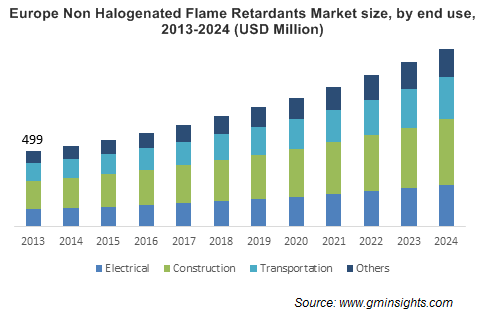Home > Chemicals & Materials > Advanced Materials > Functional Materials > Non Halogenated Flame Retardants Market
Non Halogenated Flame Retardants Market Analysis
- Report ID: GMI730
- Published Date: Aug 2016
- Report Format: PDF
Non Halogenated Flame Retardants Market Analysis
Aluminum hydroxide was valued over USD 300 million by 2015. It is widely used fillet in rubber, FRPs and polymers. It is an excellent smoke suppressant and is extremely affordable.
Phosphorus based non halogenated flame retardants will grow at over 8%. Organic phosphorous compounds will evolve due to their superior smoke suppressant properties. Chlorine and bromine-based fire suppressants are toxic in nature. Environmental regulation against usage of chlorine and bromine-based fire suppressants will growth.
Global non halogenated flame retardants market from polyolefins applications exceeded 300 kilo tons in 2015. These products require retardant material like PE, LLDPE, LDPE, PP, EVA & MDPE. Polyolefins are widely used in wires in construction, transportation and electrical industries.
Epoxy resin applications will register growth over 7% during the forecast period. Epoxy resins are used in paint coatings, adhesives and electronic equipment. Smoke suppressant additives are used to improve its fire-resistant properties.
Non halogenated flame retardants market from construction sector is expected to exceed USD 1 billion by 2024. Demand for fire safety material in construction sector will drive growth. Building materials, wires, switchboards and cables in the construction business use polymers.
Global non halogenated flame retardants market would experience a significant growth subject to increasing adoption of polymers among automotive industry. Growing adoption of polymers for electronic functions in automotive sector will complement this development. Performance matrix of products are durability, protection, insulation and lower heat and smoke emission are pertinent to the adoption of product.
Use of polymer reduces weight of automobiles by 10% resulting in fuel saving. Additionally, lighter vehicles help to reduce fuel emission levels. Propylene, ABS and other high-performance polymers are used for automotive manufacturing.
Asia Pacific will witness gains over 8% owing to the large-scale spending in India and China. Presence of manufacturing facilities coupled with fire safety concerns will boost product demand. Large scale automotive production in Latin America will drive the non-halogenated flame retardants market growth.
Rise in average income from developing economies in India and China may favor the packaging and construction industry. In 2015, over 40% of Asia Pacific construction spending was in China which translates to more than USD 1 trillion in revenue. Industry analysis suggests that the global spending on construction exceeded USD 9,000 billion in 2015.

